Loading...
SOFSA Food Justice Fund Grant Application Info Session [Optional for FJF Leaders]
Maura Ackerman42min
Maura Ackerman
Hi  everyone. We are recording this session, and it will be posted afterward, but we are here to talk about the food justice fund and our second year of grant making through SOFSA through the food justice fund. So I'm going to go through some basic information first, and then then we'll have a lot of time at the end for open ended questions and answers as well. But Thanks all for being here. So for today, the agenda is that I will go over sort of our community grant making initiative. We'll talk through some of the details for 2025
everyone. We are recording this session, and it will be posted afterward, but we are here to talk about the food justice fund and our second year of grant making through SOFSA through the food justice fund. So I'm going to go through some basic information first, and then then we'll have a lot of time at the end for open ended questions and answers as well. But Thanks all for being here. So for today, the agenda is that I will go over sort of our community grant making initiative. We'll talk through some of the details for 2025
+1
 everyone. We are recording this session, and it will be posted afterward, but we are here to talk about the food justice fund and our second year of grant making through SOFSA through the food justice fund. So I'm going to go through some basic information first, and then then we'll have a lot of time at the end for open ended questions and answers as well. But Thanks all for being here. So for today, the agenda is that I will go over sort of our community grant making initiative. We'll talk through some of the details for 2025
everyone. We are recording this session, and it will be posted afterward, but we are here to talk about the food justice fund and our second year of grant making through SOFSA through the food justice fund. So I'm going to go through some basic information first, and then then we'll have a lot of time at the end for open ended questions and answers as well. But Thanks all for being here. So for today, the agenda is that I will go over sort of our community grant making initiative. We'll talk through some of the details for 2025 Maura Ackerman
oh, the tracks will work for this year. Then we're going to actually walk through the whole of the grant application. I'll share with you the key dates that are important to remember, and then we'll do open ended Q and A. So that's our plan for this time together. It may or may not take the full 90 minutes, but we wanted to make sure that we had ample time for questions and to answer those for you all, I just want to make sure that we are recording Yes, we are okay. All right, so just an overview of 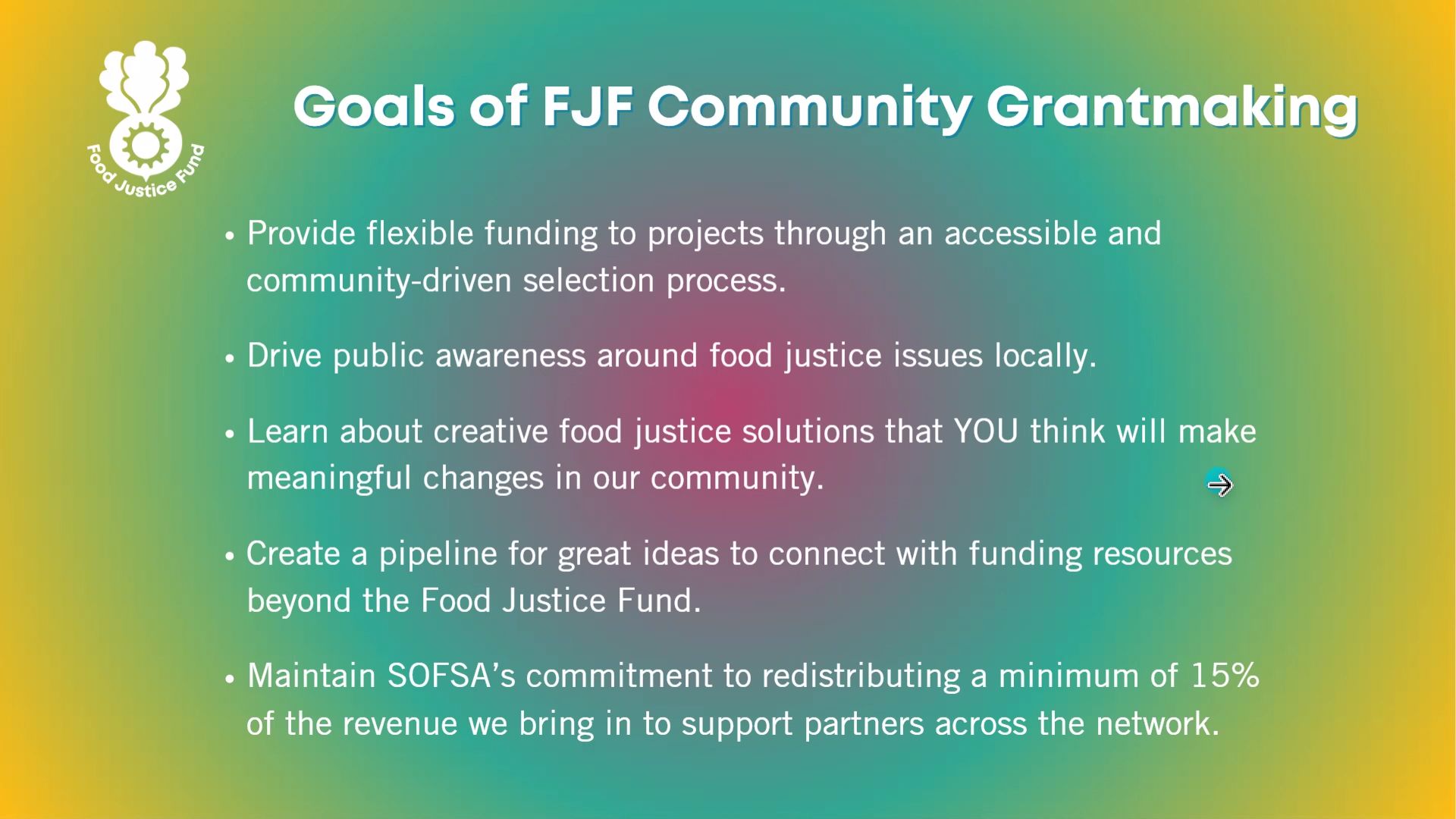
 this initiative, the goals of community grant making through the food justice fund are to provide flexible funding to projects through an accessible and community driven selection process to drive public awareness around food justice issues locally in Syracuse, Onondaga County and Onondaga Nation, to learn about creative food justice solutions that you think will make a meaningful change in our community, to create a pipeline for great ideas, to connect with funding resources beyond the food justice fund, and to maintain SOFSA commitment to redistributing a minimum of 15% of the revenue we bring in to support our partners across the network. So this is our annual timeline. The text is a little small, so I apologize, but as you might know, our food justice fund leaders are a group of folks who've applied to be part of the decision making for our grant making. Each year, they convened for the first time in January to talk to make some key decisions around around the grant and how it will function this year. We met again couple weeks ago to finalize the grant application, which went live last week. Here we are having our info session in March. You
this initiative, the goals of community grant making through the food justice fund are to provide flexible funding to projects through an accessible and community driven selection process to drive public awareness around food justice issues locally in Syracuse, Onondaga County and Onondaga Nation, to learn about creative food justice solutions that you think will make a meaningful change in our community, to create a pipeline for great ideas, to connect with funding resources beyond the food justice fund, and to maintain SOFSA commitment to redistributing a minimum of 15% of the revenue we bring in to support our partners across the network. So this is our annual timeline. The text is a little small, so I apologize, but as you might know, our food justice fund leaders are a group of folks who've applied to be part of the decision making for our grant making. Each year, they convened for the first time in January to talk to make some key decisions around around the grant and how it will function this year. We met again couple weeks ago to finalize the grant application, which went live last week. Here we are having our info session in March. You
+2

 this initiative, the goals of community grant making through the food justice fund are to provide flexible funding to projects through an accessible and community driven selection process to drive public awareness around food justice issues locally in Syracuse, Onondaga County and Onondaga Nation, to learn about creative food justice solutions that you think will make a meaningful change in our community, to create a pipeline for great ideas, to connect with funding resources beyond the food justice fund, and to maintain SOFSA commitment to redistributing a minimum of 15% of the revenue we bring in to support our partners across the network. So this is our annual timeline. The text is a little small, so I apologize, but as you might know, our food justice fund leaders are a group of folks who've applied to be part of the decision making for our grant making. Each year, they convened for the first time in January to talk to make some key decisions around around the grant and how it will function this year. We met again couple weeks ago to finalize the grant application, which went live last week. Here we are having our info session in March. You
this initiative, the goals of community grant making through the food justice fund are to provide flexible funding to projects through an accessible and community driven selection process to drive public awareness around food justice issues locally in Syracuse, Onondaga County and Onondaga Nation, to learn about creative food justice solutions that you think will make a meaningful change in our community, to create a pipeline for great ideas, to connect with funding resources beyond the food justice fund, and to maintain SOFSA commitment to redistributing a minimum of 15% of the revenue we bring in to support our partners across the network. So this is our annual timeline. The text is a little small, so I apologize, but as you might know, our food justice fund leaders are a group of folks who've applied to be part of the decision making for our grant making. Each year, they convened for the first time in January to talk to make some key decisions around around the grant and how it will function this year. We met again couple weeks ago to finalize the grant application, which went live last week. Here we are having our info session in March. You Maura Ackerman
um, starting this weekend, continuing, there's one on one application support available from Renee, who's who will be on the call, but I think is having some technical difficulties, and applications are due mid month. As you all should know, March 14 is the deadline. Then our leaders will independently review and rank all of the grant applications, and in early April, the group will meet to discuss their rankings. They'll determine which finalists will be advanced to community voting and which track two
Maura Ackerman
awardees will be selected.
Maura Ackerman
Then, beginning in late, in mid through late April, the community voting will take place for those the finalists who've been selected to move forward to community voting, and we will conclude with a gather and grant community dinner, where folks will where the there'll be a final opportunity for folks to vote, and where winners will be announced in May receive their award payments and begin work on their projects which are expected. The funds are expected to be spent down in a 12 month period. So from May 1 ish of 2025 between then and April 30, 2026 so and then finally, in October, the grant the 2025 grantees will present as part of the food justice gathering about their progress on their projects so far, and applications for the next round of the leaders, who will then determine our 2026 priorities and structure will open for that group. That's our timeline.
Maura Ackerman
As folks may know, we awarded a total of $22,000
Maura Ackerman
in 2024
Maura Ackerman
these were the seven awardees whose grants ranged from $950
Maura Ackerman
all the way to $5,000 for 2025
Maura Ackerman
I don't know where these transition things came.
Maura Ackerman
My  slides are doing their own thing. So the food justice fund leaders for 2025 made a couple of key decisions around eligibility. So one is that the project must primarily serve residents of Syracuse, Onondaga County and around and doggone nation. So the project itself doesn't need to necessarily be based directly in our area, but the primary the primary beneficiaries, need to be residents of our area. The grantee must be a 501, c3, nonprofit organization or have a fiscal sponsor with that designation. We can talk a little bit more about what that means shortly. And the first the folks who received grants in 2024 are not eligible for repeat funding in 2025 there will be further decisions with next year's cohort about how, whether 2024
slides are doing their own thing. So the food justice fund leaders for 2025 made a couple of key decisions around eligibility. So one is that the project must primarily serve residents of Syracuse, Onondaga County and around and doggone nation. So the project itself doesn't need to necessarily be based directly in our area, but the primary the primary beneficiaries, need to be residents of our area. The grantee must be a 501, c3, nonprofit organization or have a fiscal sponsor with that designation. We can talk a little bit more about what that means shortly. And the first the folks who received grants in 2024 are not eligible for repeat funding in 2025 there will be further decisions with next year's cohort about how, whether 2024
+1
 slides are doing their own thing. So the food justice fund leaders for 2025 made a couple of key decisions around eligibility. So one is that the project must primarily serve residents of Syracuse, Onondaga County and around and doggone nation. So the project itself doesn't need to necessarily be based directly in our area, but the primary the primary beneficiaries, need to be residents of our area. The grantee must be a 501, c3, nonprofit organization or have a fiscal sponsor with that designation. We can talk a little bit more about what that means shortly. And the first the folks who received grants in 2024 are not eligible for repeat funding in 2025 there will be further decisions with next year's cohort about how, whether 2024
slides are doing their own thing. So the food justice fund leaders for 2025 made a couple of key decisions around eligibility. So one is that the project must primarily serve residents of Syracuse, Onondaga County and around and doggone nation. So the project itself doesn't need to necessarily be based directly in our area, but the primary the primary beneficiaries, need to be residents of our area. The grantee must be a 501, c3, nonprofit organization or have a fiscal sponsor with that designation. We can talk a little bit more about what that means shortly. And the first the folks who received grants in 2024 are not eligible for repeat funding in 2025 there will be further decisions with next year's cohort about how, whether 2024 Maura Ackerman
grantees might be eligible, a
Maura Ackerman
little  bit of a longer waiting period between funding folks. Again, we'll see where the group falls on that the group, the Leadership Council also determined a set of funding priorities, but they don't want to be exclusively funding in these areas. These were just some of the things that we presented data around what folks shared at the food justice gathering and their exit surveys, what came out of listening sessions over the years, all of those things. And so from that, they came up with this list of five priorities, access to fresh, culturally relevant food capacity building for grassroots organizations, programs serving youth and seniors, pop up markets, community gardens and urban agriculture or something else. And any project can select up to three of these funding priorities that they think their application fits into. So you don't need to choose just one this year, and they are really open to ideas outside specific funding priorities. So definitely, if your project that you think will be high impact falls outside of these funding priorities. Please don't let that be discouraging to you. They're excited to see all of the different ideas and what do we have for funding? So in total, last year's food justice fund leaders reserved $4,000 to move forward into this year's or future years funding pot, we have $28,000 that we raised from the New York Health Foundation to support this, and then 550, $5,250, came from individual donations and support from the Onondaga ag Council through our plant to see with SOFSA campaign. So in total, the food justice fund pot is at 37,000 just over $37,000 the way that this year's group has decided to distribute that is as follows. So of the total, $37,250 in the pot, 30,000 will be granted out this year. And 72 $7,250 will be saved in the Fund for future year. This will help us. You know, seeding the Fund for the future helps us to then fundraise, to say to other funders, hey, we already have 7200 in the pot. Will you help us make it to maybe it'll be 40 next year. We'll see how far we can get. But we want to distribute 30,000 this year that will be distributed in two different tracks. So the first track is the one that you may be familiar with, if you were, you know, under or a finalist or participated in any way in last year's food justice fund, that that is the public voting track, and the community will vote to award those funds. Talk more about the the ballot. Momentarily, those grants will range from 1000 to $5,000 and we will advance up to 15 finalists to the public vote. Then in track two, this is going to be a trust based process that happens more behind the scenes, with the food justice fund determining if and how they might want to award funds that don't more directly, that go through through less
bit of a longer waiting period between funding folks. Again, we'll see where the group falls on that the group, the Leadership Council also determined a set of funding priorities, but they don't want to be exclusively funding in these areas. These were just some of the things that we presented data around what folks shared at the food justice gathering and their exit surveys, what came out of listening sessions over the years, all of those things. And so from that, they came up with this list of five priorities, access to fresh, culturally relevant food capacity building for grassroots organizations, programs serving youth and seniors, pop up markets, community gardens and urban agriculture or something else. And any project can select up to three of these funding priorities that they think their application fits into. So you don't need to choose just one this year, and they are really open to ideas outside specific funding priorities. So definitely, if your project that you think will be high impact falls outside of these funding priorities. Please don't let that be discouraging to you. They're excited to see all of the different ideas and what do we have for funding? So in total, last year's food justice fund leaders reserved $4,000 to move forward into this year's or future years funding pot, we have $28,000 that we raised from the New York Health Foundation to support this, and then 550, $5,250, came from individual donations and support from the Onondaga ag Council through our plant to see with SOFSA campaign. So in total, the food justice fund pot is at 37,000 just over $37,000 the way that this year's group has decided to distribute that is as follows. So of the total, $37,250 in the pot, 30,000 will be granted out this year. And 72 $7,250 will be saved in the Fund for future year. This will help us. You know, seeding the Fund for the future helps us to then fundraise, to say to other funders, hey, we already have 7200 in the pot. Will you help us make it to maybe it'll be 40 next year. We'll see how far we can get. But we want to distribute 30,000 this year that will be distributed in two different tracks. So the first track is the one that you may be familiar with, if you were, you know, under or a finalist or participated in any way in last year's food justice fund, that that is the public voting track, and the community will vote to award those funds. Talk more about the the ballot. Momentarily, those grants will range from 1000 to $5,000 and we will advance up to 15 finalists to the public vote. Then in track two, this is going to be a trust based process that happens more behind the scenes, with the food justice fund determining if and how they might want to award funds that don't more directly, that go through through less  of a public funding process. This The awards will be the same amount, and it will be the food justice fund leaders who determine if there are any direct awards, but they could make up to five direct awards in that track two route. So then, just to walk through the grant application, and I said this before, but just so folks are aware, we're doing this info session, really to help record all of this information and all of the questions. We'll put them all in writing and and recorded and publicize those but there is also one on one grant assistance available that it will be led by Renee mark, who's not part of the food justice fund, leader, Leadership Council, or the advisors. And Micah and I are supporting the Leadership Council alongside with Terrlicia, who is an alum from last year's leaders. But Renee is sort of separate from the process, and she's on on duty to help with anyone who needs one on one application support. So after today's info session, if you have further questions, we're going to direct you to Renee for that one on one application support. So accessing the application, there are three different pieces that I want to make sure you're aware of. One is the grant application itself. And Micah, maybe you could throw these three links in the chat for me as we're as I continue to talk, there's an instructions and frequently asked questions. Blog post that you can also read through, that has some more detail on different things, also the question posted there as well this recording. And then there's a sample ballot for you to check out. So for those track one finalists, you'll wind up in a sample ballot that goes to the public for a vote. And so that the example from last year is available for you at that link as well. Micah is going to put those three links in the chat. So just wanted to walk through the application question by question for everyone, so that you all can see sort of how the the how the questions flow, anything that's super straightforward I didn't include in this step by step, but for now, we'll just walk through things. So first, your project title, it needs to be descriptive, but should not include the organization's name or any identifying information about your particular entity who's applying the project title is really about what the impact is, what your you know, just an inspiring title that's going to be bolded if you're a finalist in the in the project ballot. So the project title is a really important public facing piece of your application. The location you're going to put an address where the most of the project activities will take place. That map will also show up on the on the public ballot. So you'll start typing an address, and then it will sort of populate, and you'll need to select so if you're you have a big coverage area and you're not delivering services in one particular site consistently, you might choose the center point of that coverage area, or you might choose a specific location. So looking at you, Galen like, right? If you were thinking about a project that was taking place primarily at interfaith community Co Op, you would select that address, but if you were talking about a city wide initiative with multiple partners involved, you might choose a center point that that better articulated, where the predominance of the services would occur. So I want to create a map that demonstrates sort of where the different projects are primarily taking place. So you're you're using a point address to represent your the area of service
of a public funding process. This The awards will be the same amount, and it will be the food justice fund leaders who determine if there are any direct awards, but they could make up to five direct awards in that track two route. So then, just to walk through the grant application, and I said this before, but just so folks are aware, we're doing this info session, really to help record all of this information and all of the questions. We'll put them all in writing and and recorded and publicize those but there is also one on one grant assistance available that it will be led by Renee mark, who's not part of the food justice fund, leader, Leadership Council, or the advisors. And Micah and I are supporting the Leadership Council alongside with Terrlicia, who is an alum from last year's leaders. But Renee is sort of separate from the process, and she's on on duty to help with anyone who needs one on one application support. So after today's info session, if you have further questions, we're going to direct you to Renee for that one on one application support. So accessing the application, there are three different pieces that I want to make sure you're aware of. One is the grant application itself. And Micah, maybe you could throw these three links in the chat for me as we're as I continue to talk, there's an instructions and frequently asked questions. Blog post that you can also read through, that has some more detail on different things, also the question posted there as well this recording. And then there's a sample ballot for you to check out. So for those track one finalists, you'll wind up in a sample ballot that goes to the public for a vote. And so that the example from last year is available for you at that link as well. Micah is going to put those three links in the chat. So just wanted to walk through the application question by question for everyone, so that you all can see sort of how the the how the questions flow, anything that's super straightforward I didn't include in this step by step, but for now, we'll just walk through things. So first, your project title, it needs to be descriptive, but should not include the organization's name or any identifying information about your particular entity who's applying the project title is really about what the impact is, what your you know, just an inspiring title that's going to be bolded if you're a finalist in the in the project ballot. So the project title is a really important public facing piece of your application. The location you're going to put an address where the most of the project activities will take place. That map will also show up on the on the public ballot. So you'll start typing an address, and then it will sort of populate, and you'll need to select so if you're you have a big coverage area and you're not delivering services in one particular site consistently, you might choose the center point of that coverage area, or you might choose a specific location. So looking at you, Galen like, right? If you were thinking about a project that was taking place primarily at interfaith community Co Op, you would select that address, but if you were talking about a city wide initiative with multiple partners involved, you might choose a center point that that better articulated, where the predominance of the services would occur. So I want to create a map that demonstrates sort of where the different projects are primarily taking place. So you're you're using a point address to represent your the area of service
+1
 bit of a longer waiting period between funding folks. Again, we'll see where the group falls on that the group, the Leadership Council also determined a set of funding priorities, but they don't want to be exclusively funding in these areas. These were just some of the things that we presented data around what folks shared at the food justice gathering and their exit surveys, what came out of listening sessions over the years, all of those things. And so from that, they came up with this list of five priorities, access to fresh, culturally relevant food capacity building for grassroots organizations, programs serving youth and seniors, pop up markets, community gardens and urban agriculture or something else. And any project can select up to three of these funding priorities that they think their application fits into. So you don't need to choose just one this year, and they are really open to ideas outside specific funding priorities. So definitely, if your project that you think will be high impact falls outside of these funding priorities. Please don't let that be discouraging to you. They're excited to see all of the different ideas and what do we have for funding? So in total, last year's food justice fund leaders reserved $4,000 to move forward into this year's or future years funding pot, we have $28,000 that we raised from the New York Health Foundation to support this, and then 550, $5,250, came from individual donations and support from the Onondaga ag Council through our plant to see with SOFSA campaign. So in total, the food justice fund pot is at 37,000 just over $37,000 the way that this year's group has decided to distribute that is as follows. So of the total, $37,250 in the pot, 30,000 will be granted out this year. And 72 $7,250 will be saved in the Fund for future year. This will help us. You know, seeding the Fund for the future helps us to then fundraise, to say to other funders, hey, we already have 7200 in the pot. Will you help us make it to maybe it'll be 40 next year. We'll see how far we can get. But we want to distribute 30,000 this year that will be distributed in two different tracks. So the first track is the one that you may be familiar with, if you were, you know, under or a finalist or participated in any way in last year's food justice fund, that that is the public voting track, and the community will vote to award those funds. Talk more about the the ballot. Momentarily, those grants will range from 1000 to $5,000 and we will advance up to 15 finalists to the public vote. Then in track two, this is going to be a trust based process that happens more behind the scenes, with the food justice fund determining if and how they might want to award funds that don't more directly, that go through through less
bit of a longer waiting period between funding folks. Again, we'll see where the group falls on that the group, the Leadership Council also determined a set of funding priorities, but they don't want to be exclusively funding in these areas. These were just some of the things that we presented data around what folks shared at the food justice gathering and their exit surveys, what came out of listening sessions over the years, all of those things. And so from that, they came up with this list of five priorities, access to fresh, culturally relevant food capacity building for grassroots organizations, programs serving youth and seniors, pop up markets, community gardens and urban agriculture or something else. And any project can select up to three of these funding priorities that they think their application fits into. So you don't need to choose just one this year, and they are really open to ideas outside specific funding priorities. So definitely, if your project that you think will be high impact falls outside of these funding priorities. Please don't let that be discouraging to you. They're excited to see all of the different ideas and what do we have for funding? So in total, last year's food justice fund leaders reserved $4,000 to move forward into this year's or future years funding pot, we have $28,000 that we raised from the New York Health Foundation to support this, and then 550, $5,250, came from individual donations and support from the Onondaga ag Council through our plant to see with SOFSA campaign. So in total, the food justice fund pot is at 37,000 just over $37,000 the way that this year's group has decided to distribute that is as follows. So of the total, $37,250 in the pot, 30,000 will be granted out this year. And 72 $7,250 will be saved in the Fund for future year. This will help us. You know, seeding the Fund for the future helps us to then fundraise, to say to other funders, hey, we already have 7200 in the pot. Will you help us make it to maybe it'll be 40 next year. We'll see how far we can get. But we want to distribute 30,000 this year that will be distributed in two different tracks. So the first track is the one that you may be familiar with, if you were, you know, under or a finalist or participated in any way in last year's food justice fund, that that is the public voting track, and the community will vote to award those funds. Talk more about the the ballot. Momentarily, those grants will range from 1000 to $5,000 and we will advance up to 15 finalists to the public vote. Then in track two, this is going to be a trust based process that happens more behind the scenes, with the food justice fund determining if and how they might want to award funds that don't more directly, that go through through less +1
 of a public funding process. This The awards will be the same amount, and it will be the food justice fund leaders who determine if there are any direct awards, but they could make up to five direct awards in that track two route. So then, just to walk through the grant application, and I said this before, but just so folks are aware, we're doing this info session, really to help record all of this information and all of the questions. We'll put them all in writing and and recorded and publicize those but there is also one on one grant assistance available that it will be led by Renee mark, who's not part of the food justice fund, leader, Leadership Council, or the advisors. And Micah and I are supporting the Leadership Council alongside with Terrlicia, who is an alum from last year's leaders. But Renee is sort of separate from the process, and she's on on duty to help with anyone who needs one on one application support. So after today's info session, if you have further questions, we're going to direct you to Renee for that one on one application support. So accessing the application, there are three different pieces that I want to make sure you're aware of. One is the grant application itself. And Micah, maybe you could throw these three links in the chat for me as we're as I continue to talk, there's an instructions and frequently asked questions. Blog post that you can also read through, that has some more detail on different things, also the question posted there as well this recording. And then there's a sample ballot for you to check out. So for those track one finalists, you'll wind up in a sample ballot that goes to the public for a vote. And so that the example from last year is available for you at that link as well. Micah is going to put those three links in the chat. So just wanted to walk through the application question by question for everyone, so that you all can see sort of how the the how the questions flow, anything that's super straightforward I didn't include in this step by step, but for now, we'll just walk through things. So first, your project title, it needs to be descriptive, but should not include the organization's name or any identifying information about your particular entity who's applying the project title is really about what the impact is, what your you know, just an inspiring title that's going to be bolded if you're a finalist in the in the project ballot. So the project title is a really important public facing piece of your application. The location you're going to put an address where the most of the project activities will take place. That map will also show up on the on the public ballot. So you'll start typing an address, and then it will sort of populate, and you'll need to select so if you're you have a big coverage area and you're not delivering services in one particular site consistently, you might choose the center point of that coverage area, or you might choose a specific location. So looking at you, Galen like, right? If you were thinking about a project that was taking place primarily at interfaith community Co Op, you would select that address, but if you were talking about a city wide initiative with multiple partners involved, you might choose a center point that that better articulated, where the predominance of the services would occur. So I want to create a map that demonstrates sort of where the different projects are primarily taking place. So you're you're using a point address to represent your the area of service
of a public funding process. This The awards will be the same amount, and it will be the food justice fund leaders who determine if there are any direct awards, but they could make up to five direct awards in that track two route. So then, just to walk through the grant application, and I said this before, but just so folks are aware, we're doing this info session, really to help record all of this information and all of the questions. We'll put them all in writing and and recorded and publicize those but there is also one on one grant assistance available that it will be led by Renee mark, who's not part of the food justice fund, leader, Leadership Council, or the advisors. And Micah and I are supporting the Leadership Council alongside with Terrlicia, who is an alum from last year's leaders. But Renee is sort of separate from the process, and she's on on duty to help with anyone who needs one on one application support. So after today's info session, if you have further questions, we're going to direct you to Renee for that one on one application support. So accessing the application, there are three different pieces that I want to make sure you're aware of. One is the grant application itself. And Micah, maybe you could throw these three links in the chat for me as we're as I continue to talk, there's an instructions and frequently asked questions. Blog post that you can also read through, that has some more detail on different things, also the question posted there as well this recording. And then there's a sample ballot for you to check out. So for those track one finalists, you'll wind up in a sample ballot that goes to the public for a vote. And so that the example from last year is available for you at that link as well. Micah is going to put those three links in the chat. So just wanted to walk through the application question by question for everyone, so that you all can see sort of how the the how the questions flow, anything that's super straightforward I didn't include in this step by step, but for now, we'll just walk through things. So first, your project title, it needs to be descriptive, but should not include the organization's name or any identifying information about your particular entity who's applying the project title is really about what the impact is, what your you know, just an inspiring title that's going to be bolded if you're a finalist in the in the project ballot. So the project title is a really important public facing piece of your application. The location you're going to put an address where the most of the project activities will take place. That map will also show up on the on the public ballot. So you'll start typing an address, and then it will sort of populate, and you'll need to select so if you're you have a big coverage area and you're not delivering services in one particular site consistently, you might choose the center point of that coverage area, or you might choose a specific location. So looking at you, Galen like, right? If you were thinking about a project that was taking place primarily at interfaith community Co Op, you would select that address, but if you were talking about a city wide initiative with multiple partners involved, you might choose a center point that that better articulated, where the predominance of the services would occur. So I want to create a map that demonstrates sort of where the different projects are primarily taking place. So you're you're using a point address to represent your the area of service Maura Ackerman
nonprofit status.
Maura Ackerman
So there are three options for this. So you are you might be like SOFSA and be in the process of getting your own IRS status. We we can talk to you if you are actively in that pipeline and have submitted your form, 1023 to the IRS, we can talk about that, because we may be able to do something on a provisional basis. If you've not yet submitted a 1023 to become your own. 501, c3 you either need to have a you need to have a fiscal sponsor, or perhaps, if you're doing putting together a proposal and collaboration, you could think about the partners who does have that status being the lead on the application, and then and then other partners being sort of sub sub awardees in some way. But you will need a 501 c3 non profit organization in order to be able to apply. So if you do not have nonprofit status and need help to connect with a partner organization, Renee can also support you with that. You can apply. If you have not yet identified a fiscal sponsor, we will not release funds until we have a 501 c3 organization identified that will accept the funds on your behalf. Questions on that, the Fiscal Sponsorship stuff is a little technical.
Maura Ackerman
All right, we'll return to it if we need to later on.
Maura Ackerman
So then you're going to share your organization's annual budget. This is a question coming from the food justice fund leaders themselves, they really want to have a sense of is your a brand new grassroots initiative with very little budget, versus an established nonprofit organization that has, you know, over a million dollar budget. Where are you stacking up in terms of your organization size and its existing fiscal resources to help them prioritize their decision making. So if you are an established nonprofit organization, you want to share your total annual budget plan for 2025 if you're a grassroots initiative or a fiscally sponsored group in some way, try to give an estimate of the total amount you spent on your initiatives in 2024 so you're going to look backward, if you're a smaller group, and thinking about what you've spent in the prior year. And if you're established, you're going to look you're going to say what your overall planned budget is for the year already. And if you're somewhere in between, we trust you try to approximate, but the intent is that we're trying to the scale of the work that you're doing and the scale of the fiscal resources at your disposal. Currently, the questions 10 and 11 are really check off questions. We want you to check all five of these boxes, but you are basically confirming that again, you are eligible. You serve this group of Syracuse Onondaga County or Onondaga Nation residents that will be the primary project area, and that you'll provide a valid tax ID number for a nonprofit organization to accept the award. And then the three reporting requirements, again, we're trying to keep this as an accessible a funding stream as possible, so the reporting requirements are intended to  be low and focus on storytelling, both oral storytelling and video or photography, as opposed to long form writing or data tracking or numbers or anything like that. A more traditional place asking for is for you to tell us the story of the impact. So that's going to include sitting on a panel at the food justice gathering. Many of you may have seen that last year to share about the project results in the first six months, sharing back three to five photos or video with of your project with the SOFSA network. And then we'll also be asking for an awardee survey to help us continue to refine the process as we continue to improve over time, how our funding takes place and is most responsive to the community's needs. Oops, question 12, I talked about this a little bit when we went through the funding priorities, you can select up to three of these, and if you click something else exciting, it will pop up with an other category that will ask you to to sort of identify what's the other priority that's not included in our list that you think your project hits. So that will be very helpful to
be low and focus on storytelling, both oral storytelling and video or photography, as opposed to long form writing or data tracking or numbers or anything like that. A more traditional place asking for is for you to tell us the story of the impact. So that's going to include sitting on a panel at the food justice gathering. Many of you may have seen that last year to share about the project results in the first six months, sharing back three to five photos or video with of your project with the SOFSA network. And then we'll also be asking for an awardee survey to help us continue to refine the process as we continue to improve over time, how our funding takes place and is most responsive to the community's needs. Oops, question 12, I talked about this a little bit when we went through the funding priorities, you can select up to three of these, and if you click something else exciting, it will pop up with an other category that will ask you to to sort of identify what's the other priority that's not included in our list that you think your project hits. So that will be very helpful to
+1
 be low and focus on storytelling, both oral storytelling and video or photography, as opposed to long form writing or data tracking or numbers or anything like that. A more traditional place asking for is for you to tell us the story of the impact. So that's going to include sitting on a panel at the food justice gathering. Many of you may have seen that last year to share about the project results in the first six months, sharing back three to five photos or video with of your project with the SOFSA network. And then we'll also be asking for an awardee survey to help us continue to refine the process as we continue to improve over time, how our funding takes place and is most responsive to the community's needs. Oops, question 12, I talked about this a little bit when we went through the funding priorities, you can select up to three of these, and if you click something else exciting, it will pop up with an other category that will ask you to to sort of identify what's the other priority that's not included in our list that you think your project hits. So that will be very helpful to
be low and focus on storytelling, both oral storytelling and video or photography, as opposed to long form writing or data tracking or numbers or anything like that. A more traditional place asking for is for you to tell us the story of the impact. So that's going to include sitting on a panel at the food justice gathering. Many of you may have seen that last year to share about the project results in the first six months, sharing back three to five photos or video with of your project with the SOFSA network. And then we'll also be asking for an awardee survey to help us continue to refine the process as we continue to improve over time, how our funding takes place and is most responsive to the community's needs. Oops, question 12, I talked about this a little bit when we went through the funding priorities, you can select up to three of these, and if you click something else exciting, it will pop up with an other category that will ask you to to sort of identify what's the other priority that's not included in our list that you think your project hits. So that will be very helpful to Maura Ackerman
sort of how to move forward a diversity of projects that that fit different areas. Question 13, this will also appear in the in the public ballot. I have a chart at the end that goes through what's in the public ballot versus what's only seen by the leadership council, and I think that'll be helpful to you all. But we really want a short paragraph, five to eight sentences, probably shorter is better really identifying your project's goals, the timeline. This is intended to be a public facing description of what it is that you'll do. We may shorten these if needed for the public ballot, but this will be the basis of what is included in the public ballot, so making sure that you're doing really good case making to folks who might not know a whole lot about community gardens or might not know what kind of capacity building a grassroots organization might need in terms of training on movement building or fundraising support, or whatever else that capacity building might look like. So so doing some you know, sort of a both and making the case and sharing and building public awareness as you're as you're crafting this project overview, the funding amount requested, this is pretty basic, but definitely you're going to enter an amount less than $5,000 we'd like for all of the requests to be over $1,000 just it makes it a little bit easier. We don't want to give out like $5,500 grants. Our hope is to, do you know, around 10 ish grants and so that so in that three to five or, sorry, one to five range would be really helpful. We want to encourage you so in most for those of you who has in the past in more traditional funding streams, you might be used to sort of making your budget stretch to the maximum that you could ask for from that funder. Right? That's a very common strategy in fundraising for those of us who write grants more regularly, because this is public facing and sort of weighted in a different way because of the way the public votes on it, we really want to encourage you to not ask for $5,000 flat. We want you to ask for the money you need to make this project work, but really be demonstrating a good value for the money. We definitely saw last year that
Maura Ackerman
that projects that were asking for less than $5,000
Maura Ackerman
you know, were a little bit easier for folks to fit into their budgeting when they were doing the public voting, and so making sure that you're asking for the right size amount for the project that you're proposing, versus making your budget come together to equal 5000
Maura Ackerman
you get there and help with that case making of bulleting out a list of what are the different costs that you are including in that total that you've entered into line 15. And then question 17 is, is your project willing to accept partial funding, again, that would be with a minimum of $1,000 so the intent of this question is, let's see, how can I say this in the most clear way? So when we get to knapsack voting, which is in that in that public ballot, you'll notice that there's frequently no way to build a full budget 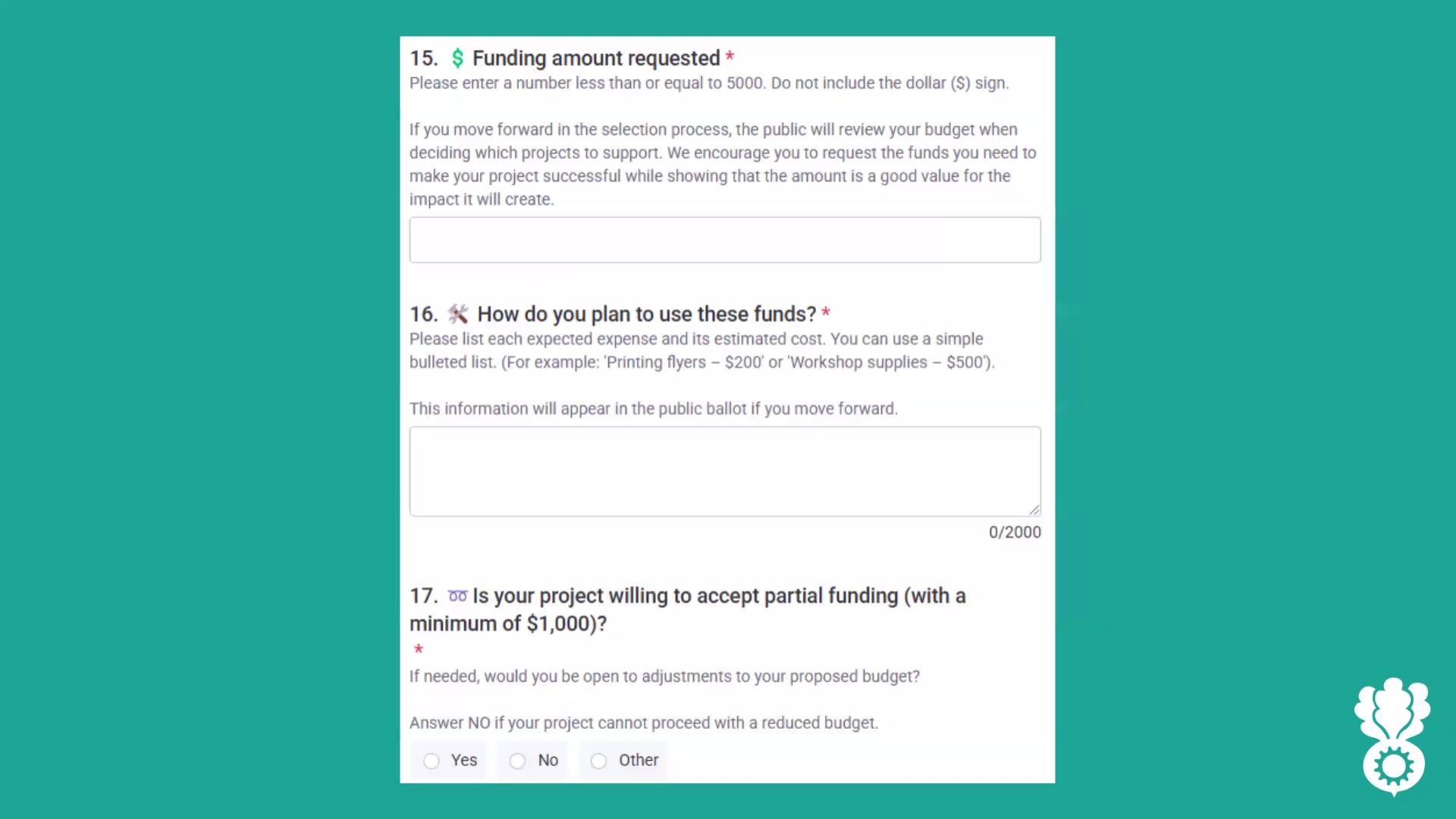
 that uses 100% of the funds. So rather than saying, okay, all of those funds automatically go towards next year, we can allocate a smaller amount of funds of that remainder into certain projects. So if, if folks are willing to accept a if your project is like, it's, I'm I'm buying a tractor, and it's $3,700 or nothing, right? If I, if I don't get the full 37,030 700 I can't buy the tractor. So please don't fund me in a partial way my project, my project doesn't have value unless it meets my whole budget. That's when you would say, No. If you could, if you could do something with a smaller amount of money that's still in the in the in line with what your what you've proposed in your project, please select Yes and there is an other spot. So if there's something else or the circumstances are a little fuzzier, feel free to reach out to Renee or to just select other and describe a little bit more about what's happening with your funding. You will be asked to upload a photo. So this could be, if you need to use a stock photo, you can, but we would really love photos that represent the work that you've done already, folks who are behind your project. Having people in those photos really matters. But this is the this is the the photo that will go alongside your entry in the public ballot if you're a finalist, if you're a track one finalist, and will be used in other contexts to promote your project as well. So great. A great photo is important. This is a repeat, sorry, let's see. And then finally, question 19. This is a question really intended to help the food justice fund leaders understand if folks are facing imminent threats to their programs based on what's happening on the federal scale. This will all be confidential. SOFSA May anonymize your stories and bring them to elected officials down the road, but this will be held in the strictest confidence by the leadership team. This is intended as a way to help us get funds more readily to folks who are being impacted by some of these downstream impacts. And so I think question 19 is likely to have the biggest impact on whether somebody moves into a track two award, or
that uses 100% of the funds. So rather than saying, okay, all of those funds automatically go towards next year, we can allocate a smaller amount of funds of that remainder into certain projects. So if, if folks are willing to accept a if your project is like, it's, I'm I'm buying a tractor, and it's $3,700 or nothing, right? If I, if I don't get the full 37,030 700 I can't buy the tractor. So please don't fund me in a partial way my project, my project doesn't have value unless it meets my whole budget. That's when you would say, No. If you could, if you could do something with a smaller amount of money that's still in the in the in line with what your what you've proposed in your project, please select Yes and there is an other spot. So if there's something else or the circumstances are a little fuzzier, feel free to reach out to Renee or to just select other and describe a little bit more about what's happening with your funding. You will be asked to upload a photo. So this could be, if you need to use a stock photo, you can, but we would really love photos that represent the work that you've done already, folks who are behind your project. Having people in those photos really matters. But this is the this is the the photo that will go alongside your entry in the public ballot if you're a finalist, if you're a track one finalist, and will be used in other contexts to promote your project as well. So great. A great photo is important. This is a repeat, sorry, let's see. And then finally, question 19. This is a question really intended to help the food justice fund leaders understand if folks are facing imminent threats to their programs based on what's happening on the federal scale. This will all be confidential. SOFSA May anonymize your stories and bring them to elected officials down the road, but this will be held in the strictest confidence by the leadership team. This is intended as a way to help us get funds more readily to folks who are being impacted by some of these downstream impacts. And so I think question 19 is likely to have the biggest impact on whether somebody moves into a track two award, or  if they're in a track one award, so you can anticipate that. So definitely, if you have impacts that you've already experienced, or you have impacts that you expect to experience, please check, check one of those two boxes, further questions will appear that ask you to describe a little bit about what's going on so that we can have that information in the future, so that that is sort of what the purpose is. But again, that is all confidential, internal information that just helps with our decision making about track one, track two, and helps us prioritize in the current context, question 20 we also know
if they're in a track one award, so you can anticipate that. So definitely, if you have impacts that you've already experienced, or you have impacts that you expect to experience, please check, check one of those two boxes, further questions will appear that ask you to describe a little bit about what's going on so that we can have that information in the future, so that that is sort of what the purpose is. But again, that is all confidential, internal information that just helps with our decision making about track one, track two, and helps us prioritize in the current context, question 20 we also know
+2

 that uses 100% of the funds. So rather than saying, okay, all of those funds automatically go towards next year, we can allocate a smaller amount of funds of that remainder into certain projects. So if, if folks are willing to accept a if your project is like, it's, I'm I'm buying a tractor, and it's $3,700 or nothing, right? If I, if I don't get the full 37,030 700 I can't buy the tractor. So please don't fund me in a partial way my project, my project doesn't have value unless it meets my whole budget. That's when you would say, No. If you could, if you could do something with a smaller amount of money that's still in the in the in line with what your what you've proposed in your project, please select Yes and there is an other spot. So if there's something else or the circumstances are a little fuzzier, feel free to reach out to Renee or to just select other and describe a little bit more about what's happening with your funding. You will be asked to upload a photo. So this could be, if you need to use a stock photo, you can, but we would really love photos that represent the work that you've done already, folks who are behind your project. Having people in those photos really matters. But this is the this is the the photo that will go alongside your entry in the public ballot if you're a finalist, if you're a track one finalist, and will be used in other contexts to promote your project as well. So great. A great photo is important. This is a repeat, sorry, let's see. And then finally, question 19. This is a question really intended to help the food justice fund leaders understand if folks are facing imminent threats to their programs based on what's happening on the federal scale. This will all be confidential. SOFSA May anonymize your stories and bring them to elected officials down the road, but this will be held in the strictest confidence by the leadership team. This is intended as a way to help us get funds more readily to folks who are being impacted by some of these downstream impacts. And so I think question 19 is likely to have the biggest impact on whether somebody moves into a track two award, or
that uses 100% of the funds. So rather than saying, okay, all of those funds automatically go towards next year, we can allocate a smaller amount of funds of that remainder into certain projects. So if, if folks are willing to accept a if your project is like, it's, I'm I'm buying a tractor, and it's $3,700 or nothing, right? If I, if I don't get the full 37,030 700 I can't buy the tractor. So please don't fund me in a partial way my project, my project doesn't have value unless it meets my whole budget. That's when you would say, No. If you could, if you could do something with a smaller amount of money that's still in the in the in line with what your what you've proposed in your project, please select Yes and there is an other spot. So if there's something else or the circumstances are a little fuzzier, feel free to reach out to Renee or to just select other and describe a little bit more about what's happening with your funding. You will be asked to upload a photo. So this could be, if you need to use a stock photo, you can, but we would really love photos that represent the work that you've done already, folks who are behind your project. Having people in those photos really matters. But this is the this is the the photo that will go alongside your entry in the public ballot if you're a finalist, if you're a track one finalist, and will be used in other contexts to promote your project as well. So great. A great photo is important. This is a repeat, sorry, let's see. And then finally, question 19. This is a question really intended to help the food justice fund leaders understand if folks are facing imminent threats to their programs based on what's happening on the federal scale. This will all be confidential. SOFSA May anonymize your stories and bring them to elected officials down the road, but this will be held in the strictest confidence by the leadership team. This is intended as a way to help us get funds more readily to folks who are being impacted by some of these downstream impacts. And so I think question 19 is likely to have the biggest impact on whether somebody moves into a track two award, or +1
 if they're in a track one award, so you can anticipate that. So definitely, if you have impacts that you've already experienced, or you have impacts that you expect to experience, please check, check one of those two boxes, further questions will appear that ask you to describe a little bit about what's going on so that we can have that information in the future, so that that is sort of what the purpose is. But again, that is all confidential, internal information that just helps with our decision making about track one, track two, and helps us prioritize in the current context, question 20 we also know
if they're in a track one award, so you can anticipate that. So definitely, if you have impacts that you've already experienced, or you have impacts that you expect to experience, please check, check one of those two boxes, further questions will appear that ask you to describe a little bit about what's going on so that we can have that information in the future, so that that is sort of what the purpose is. But again, that is all confidential, internal information that just helps with our decision making about track one, track two, and helps us prioritize in the current context, question 20 we also know Maura Ackerman
the folks, the person putting this grant application together, is right? We want to understand the writing that's in this application. Is this somebody who's a full time professional grant writer, in which case we have some different expectations of the way that they might write this application compared to somebody who this is their very first time seeking funding. And so we want to make sure we're categorizing as we read through different applications, things appropriately. So please, this is, this is for the primary person who wrote the majority of what's included. We we anticipate that a lot of you will be co writing, right? There's a lot of collaboration and partnership that it takes to do food justice work well. So just identify who the primary writer is, and that's the person who's who you're responding to this question around, and then just this is the chart that I wanted to outline for you all of which parts of the application are public facing versus which ones are internally facing. For the food justice fund Leadership Council only that will help inform their decisions, but won't be in the public facing documents. So this year, the organization's name will not be included in in what goes out to the public only the project title, the project location, will be included in the public ballot. The priority areas will, I believe we can tag those. That's the hope. A short version of your project overview will go in there, the funding amount requested, how the funds will be used in the project photo. So those are the elements that will be in the public ballot. Everything in that left hand column is confidential information that will only be read by the food justice leadership, food justice fund Leadership Council 
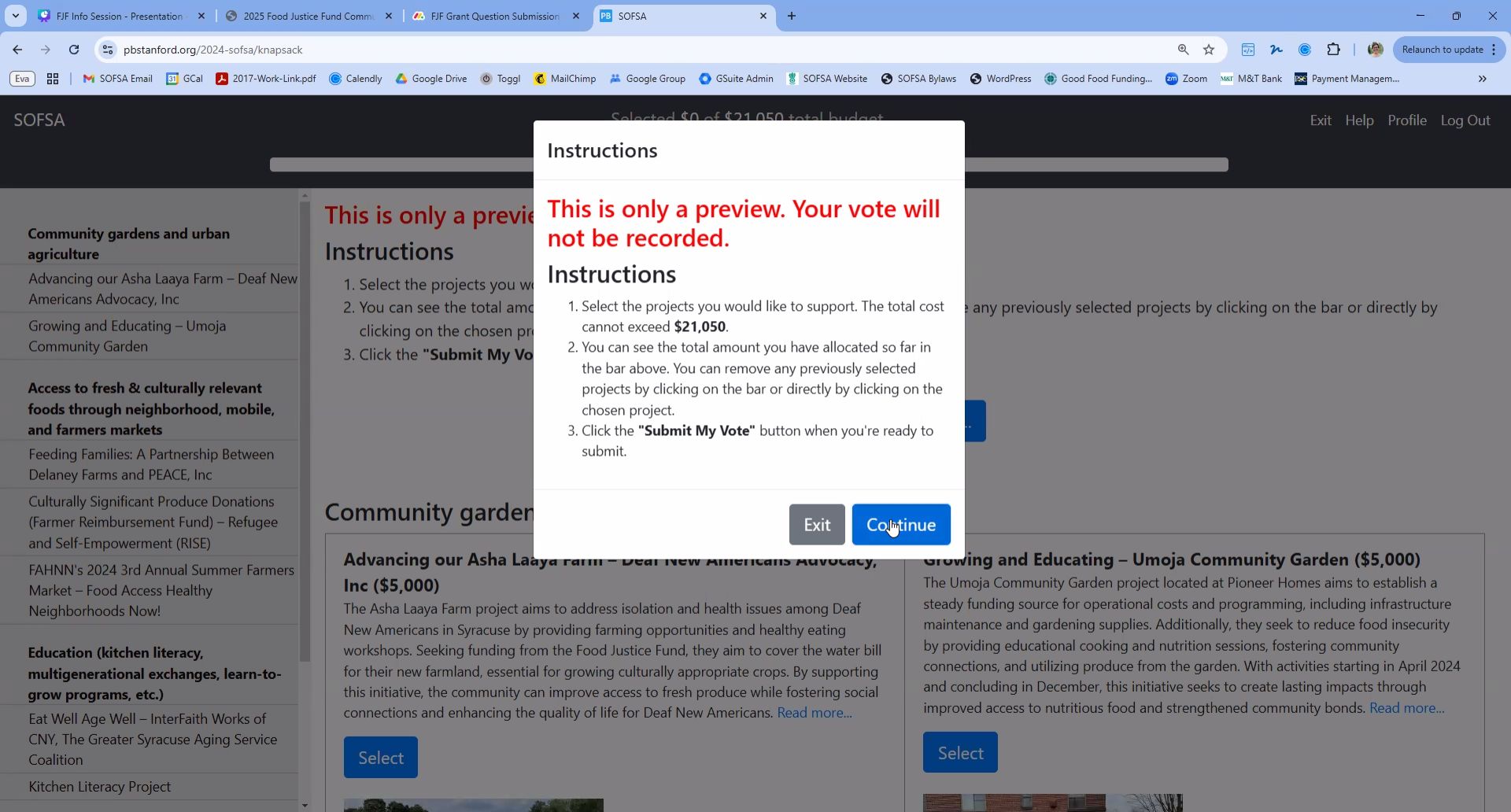
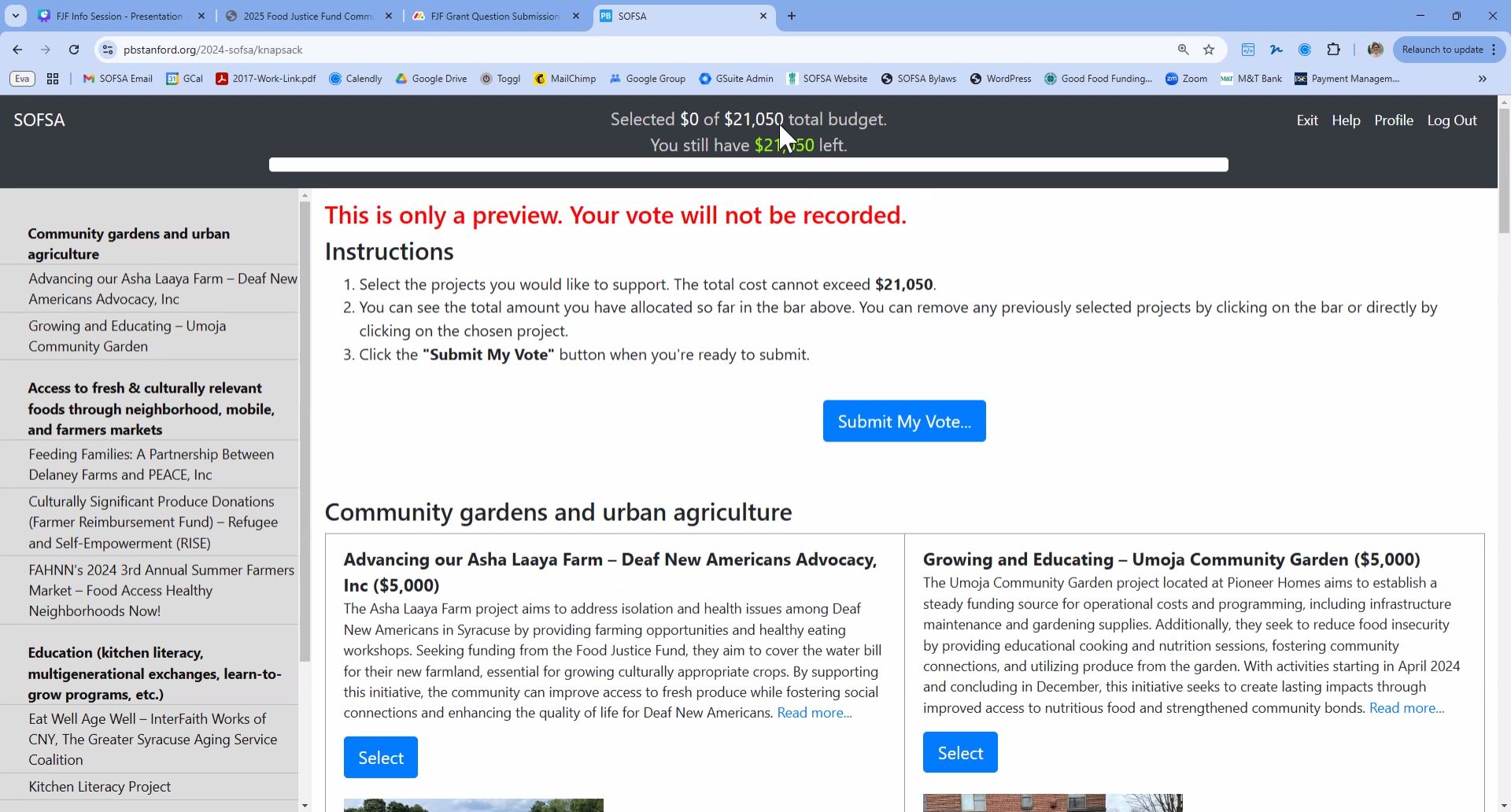
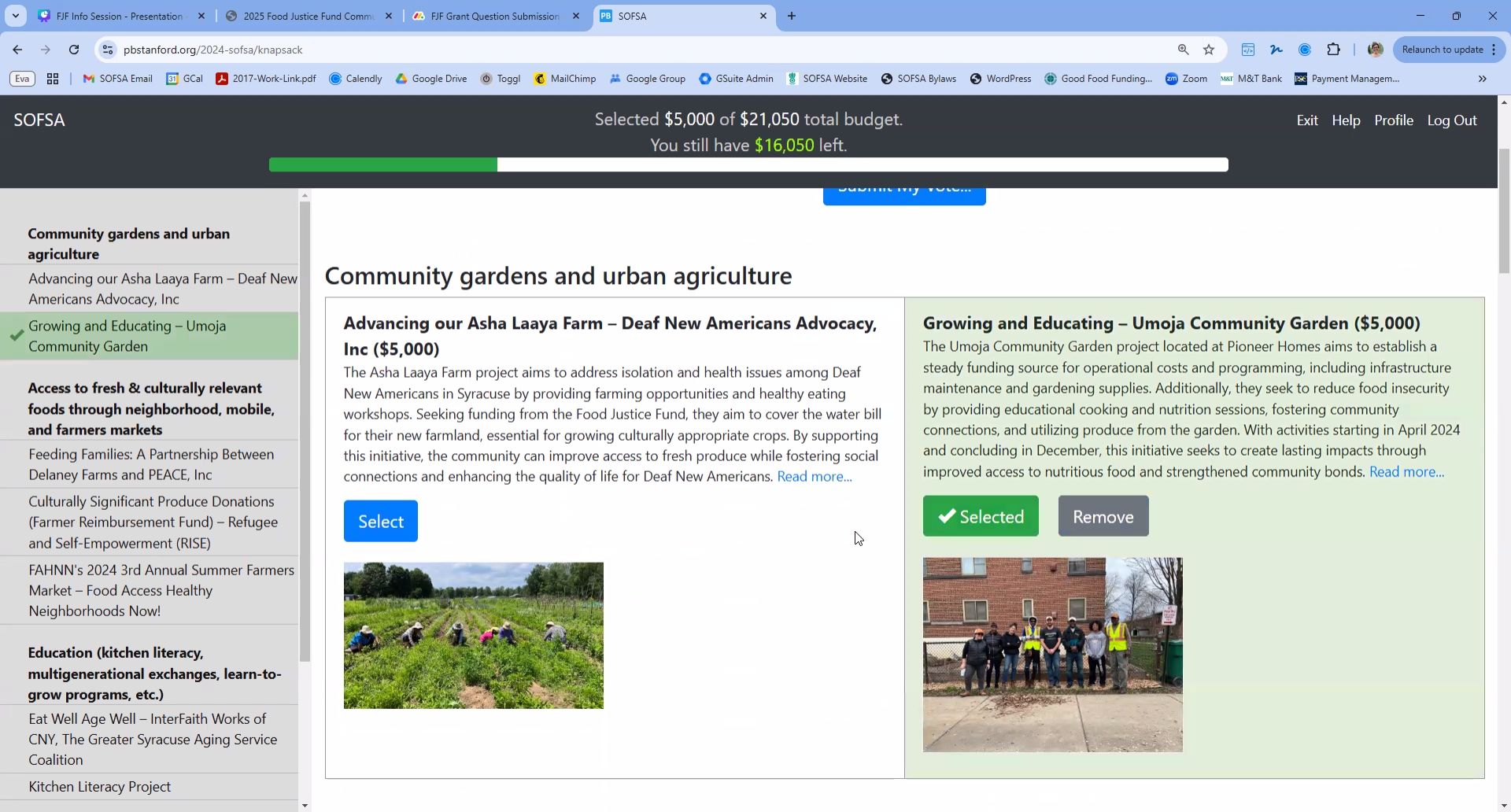
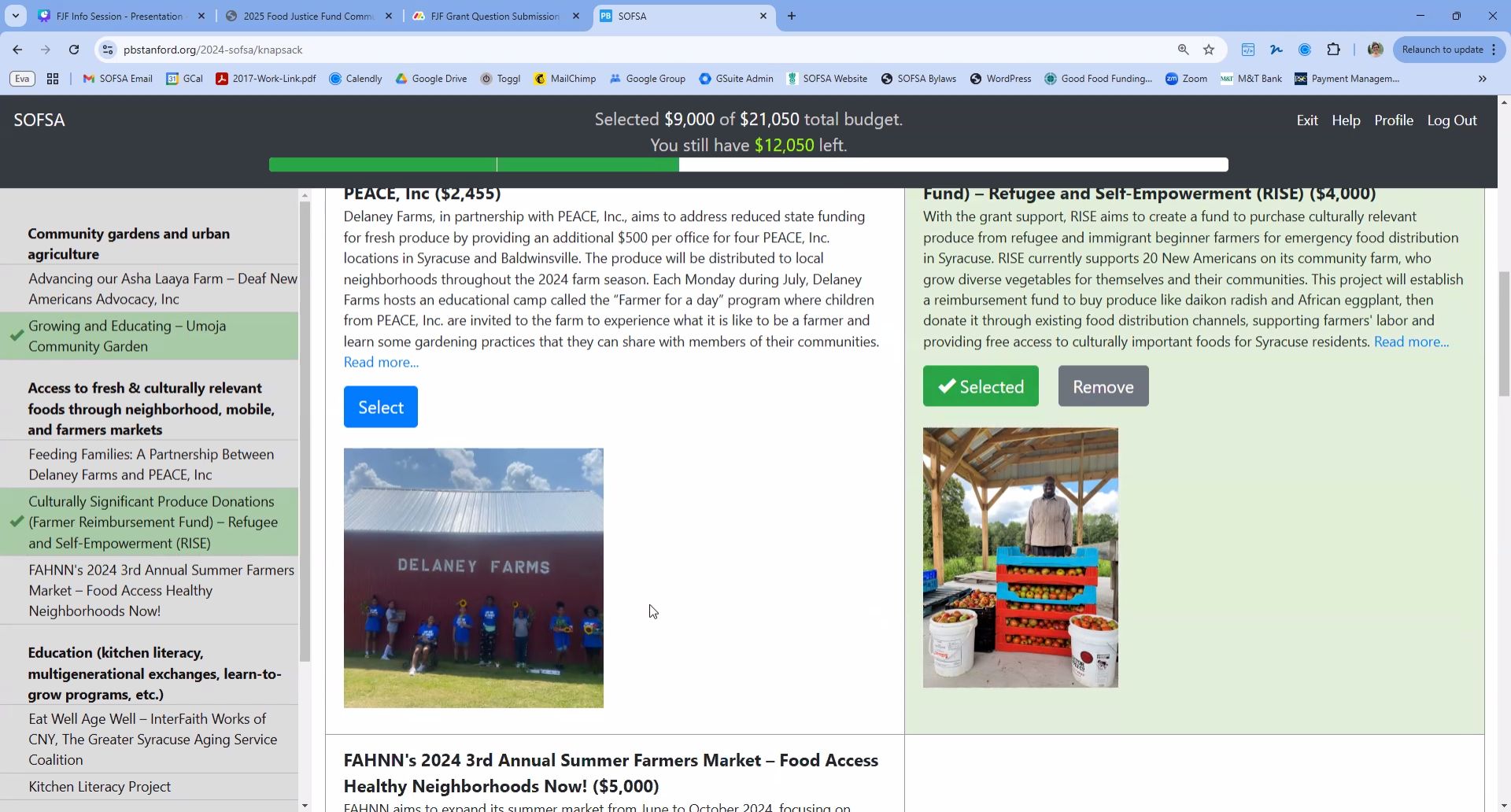
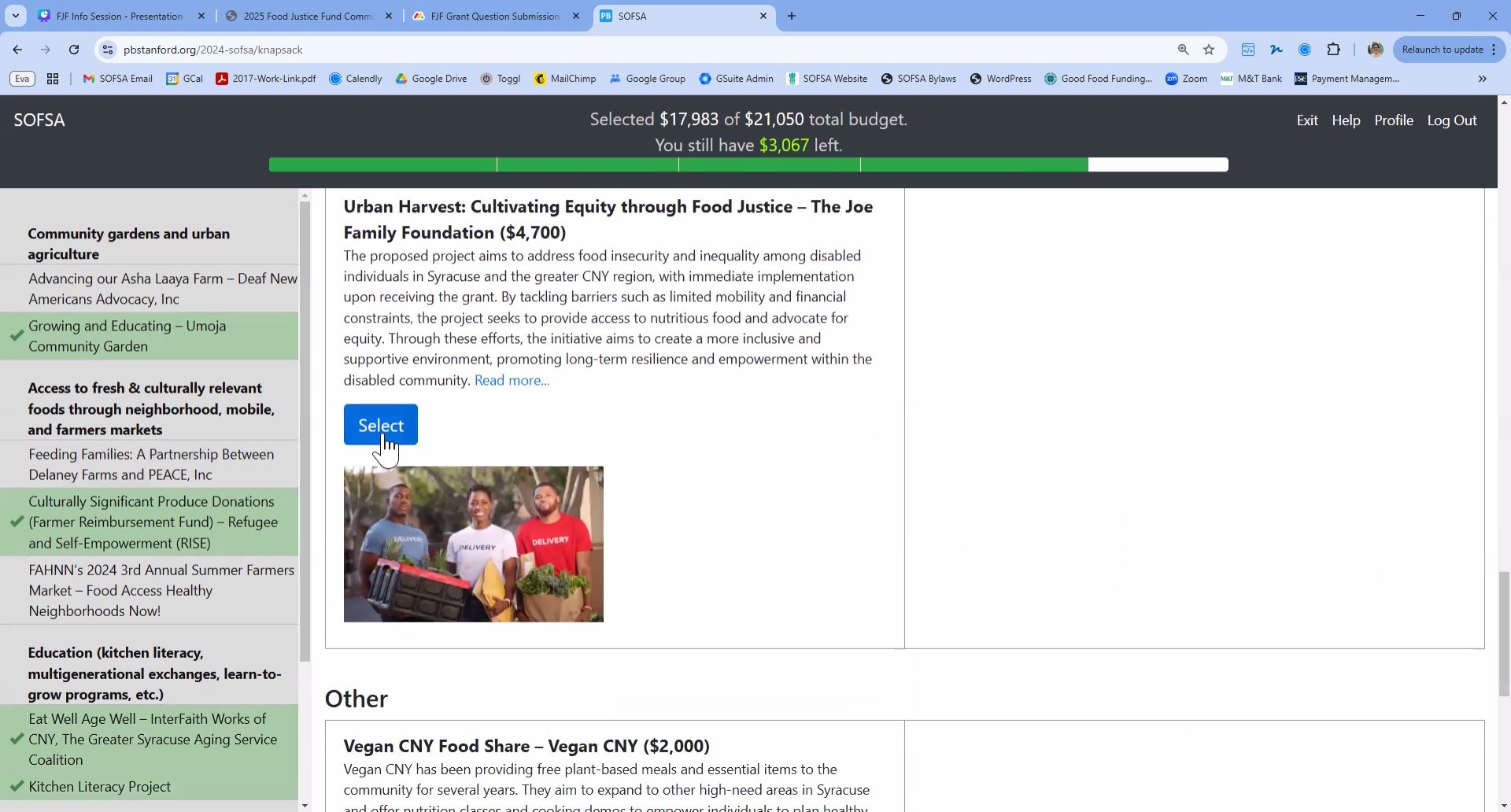
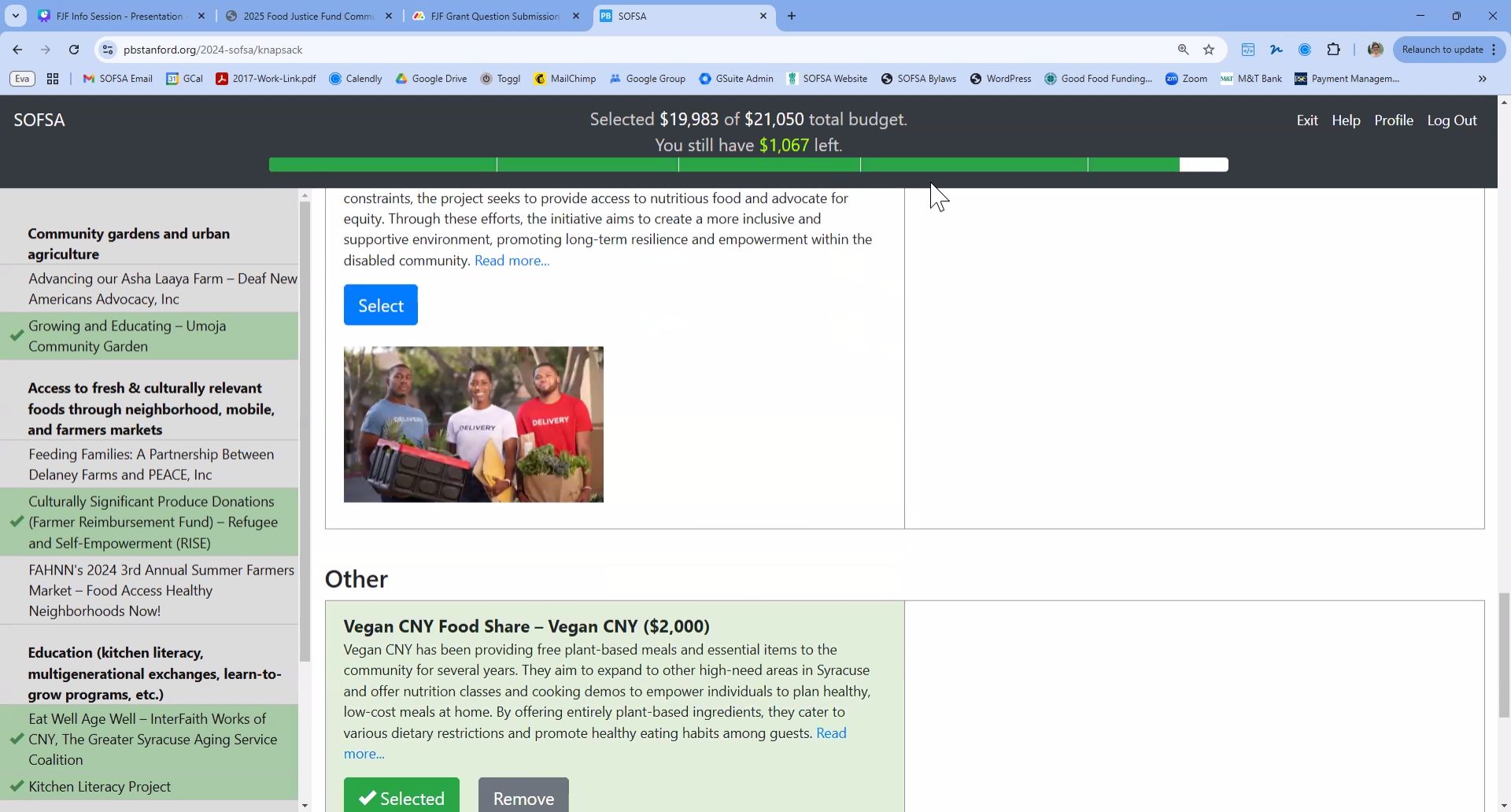
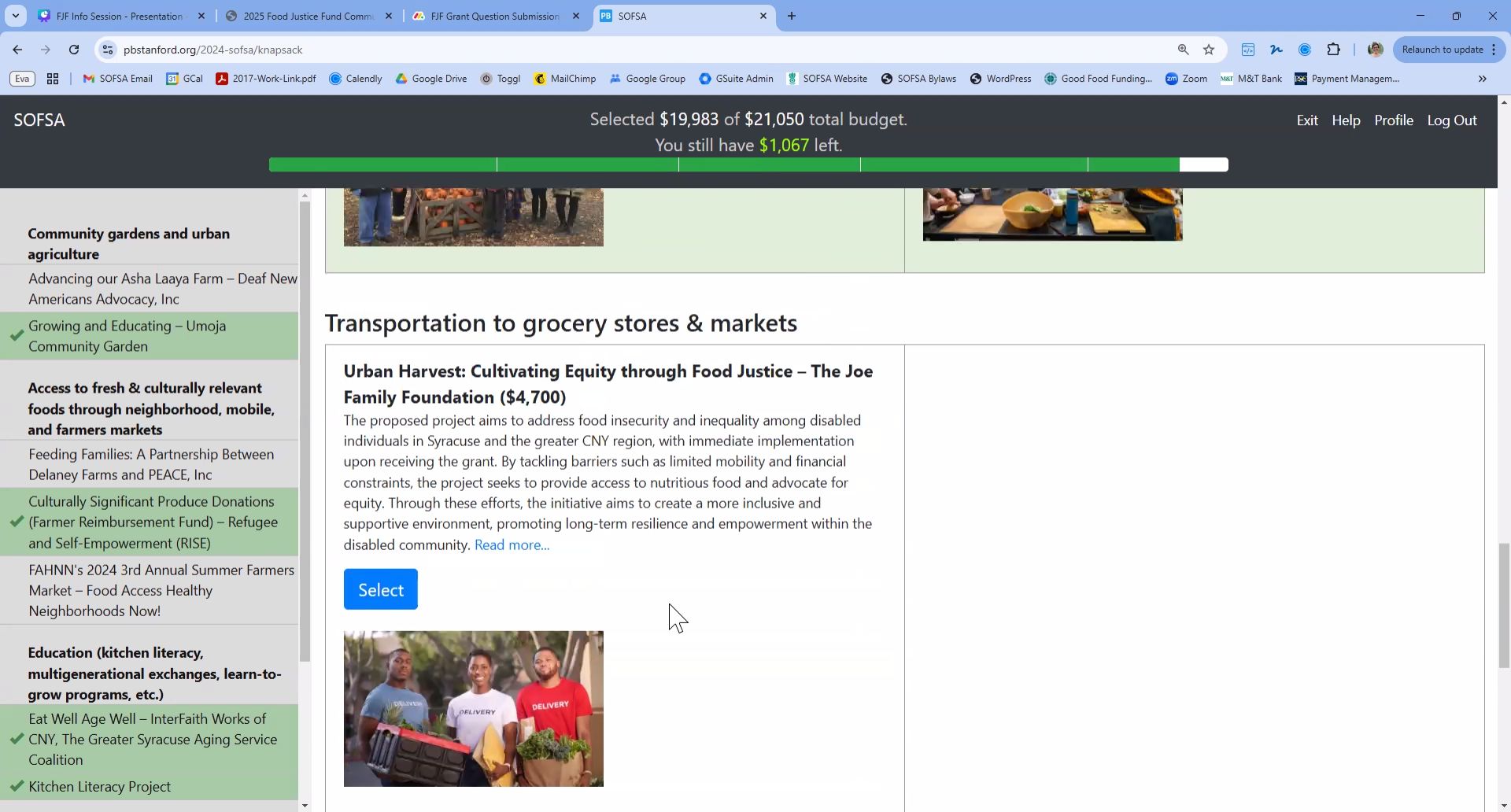
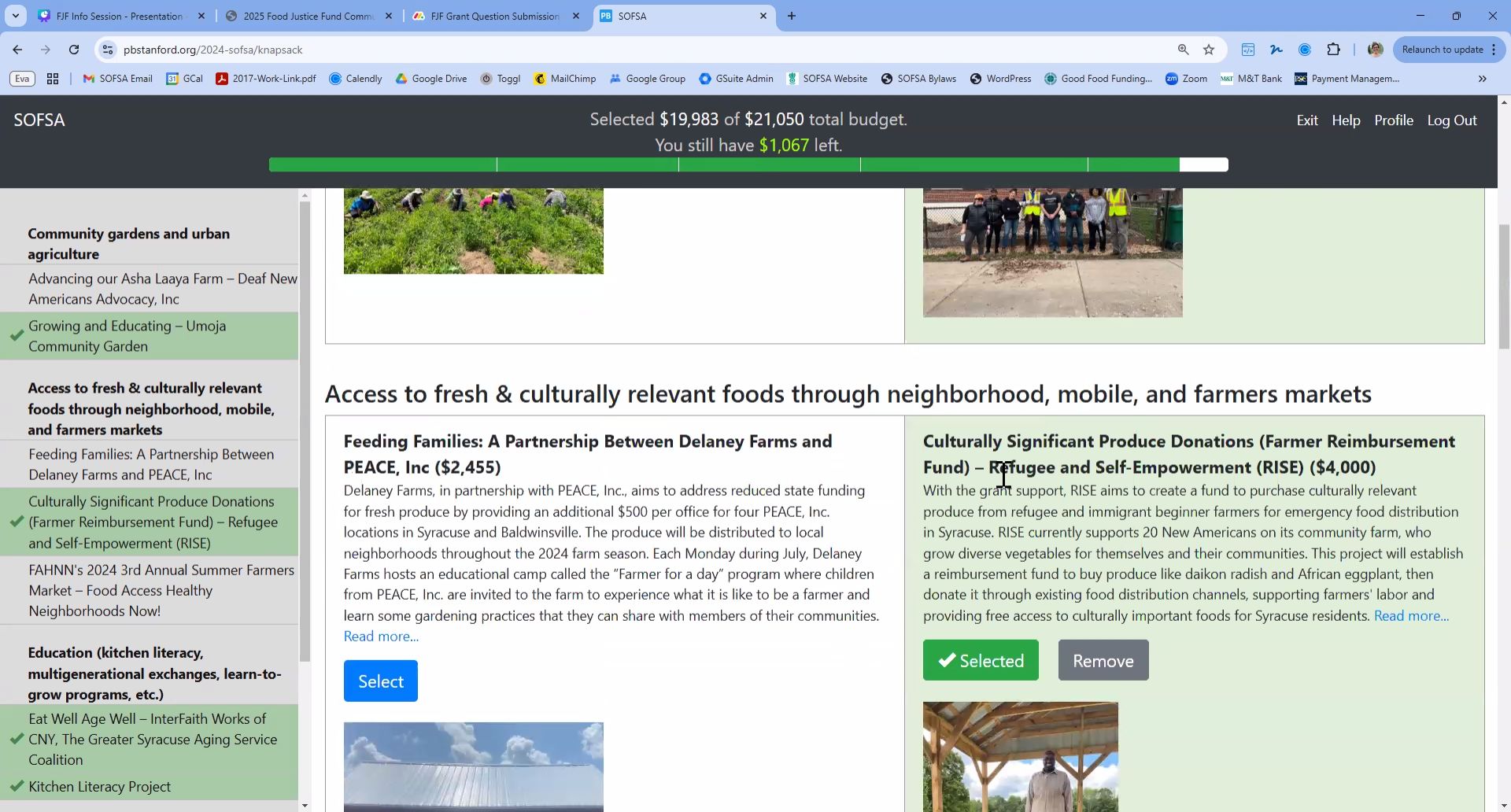

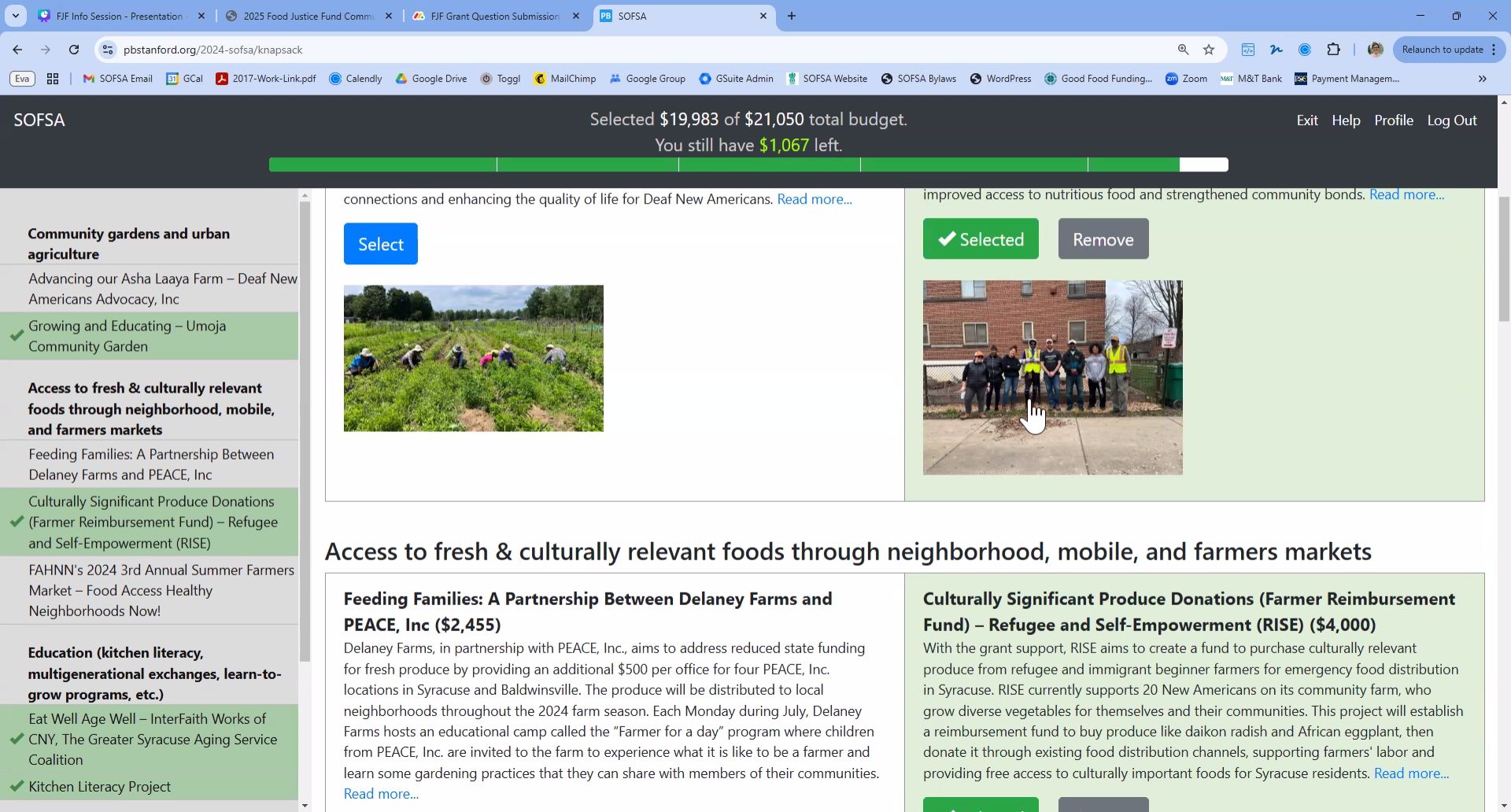
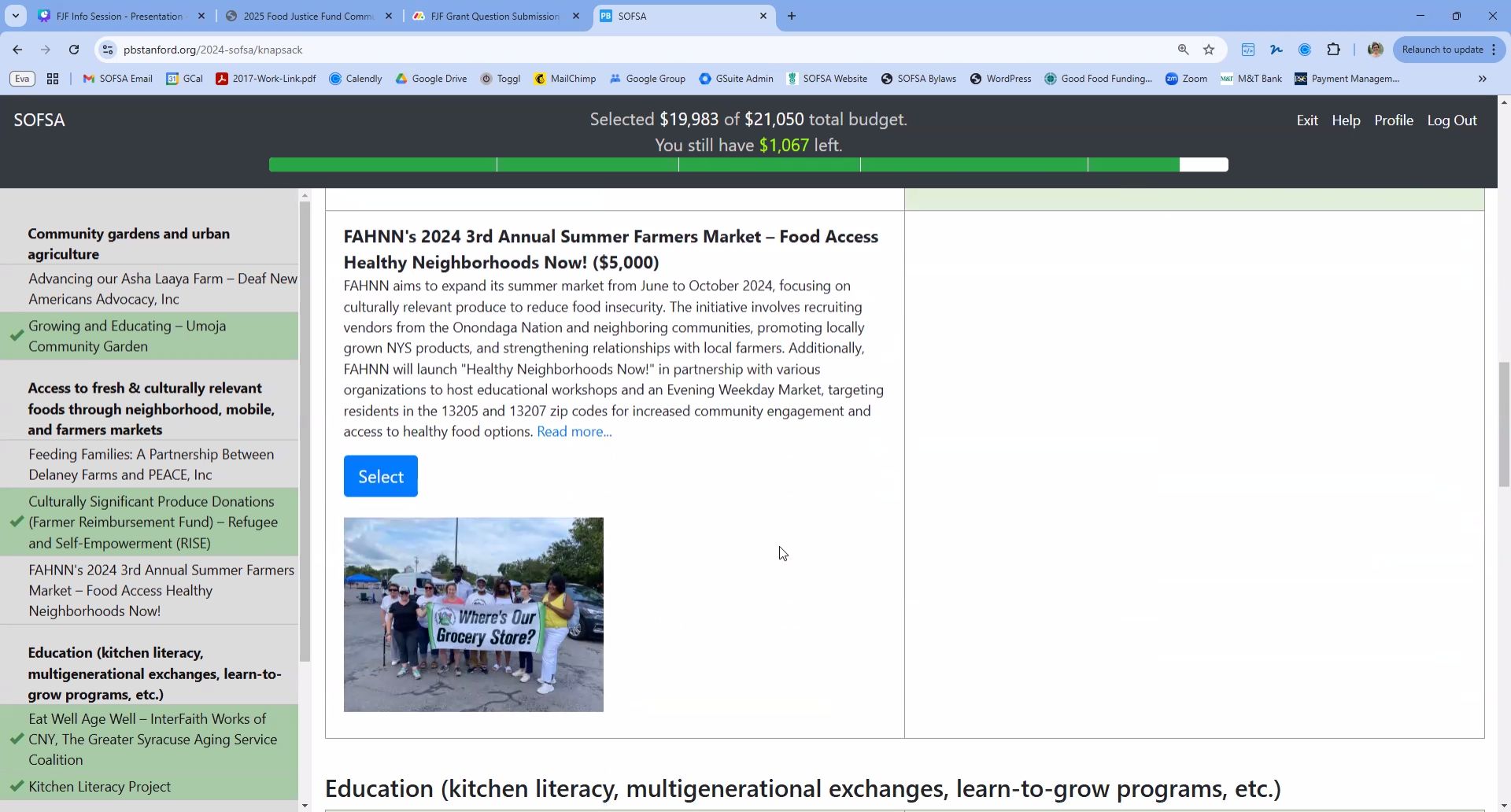
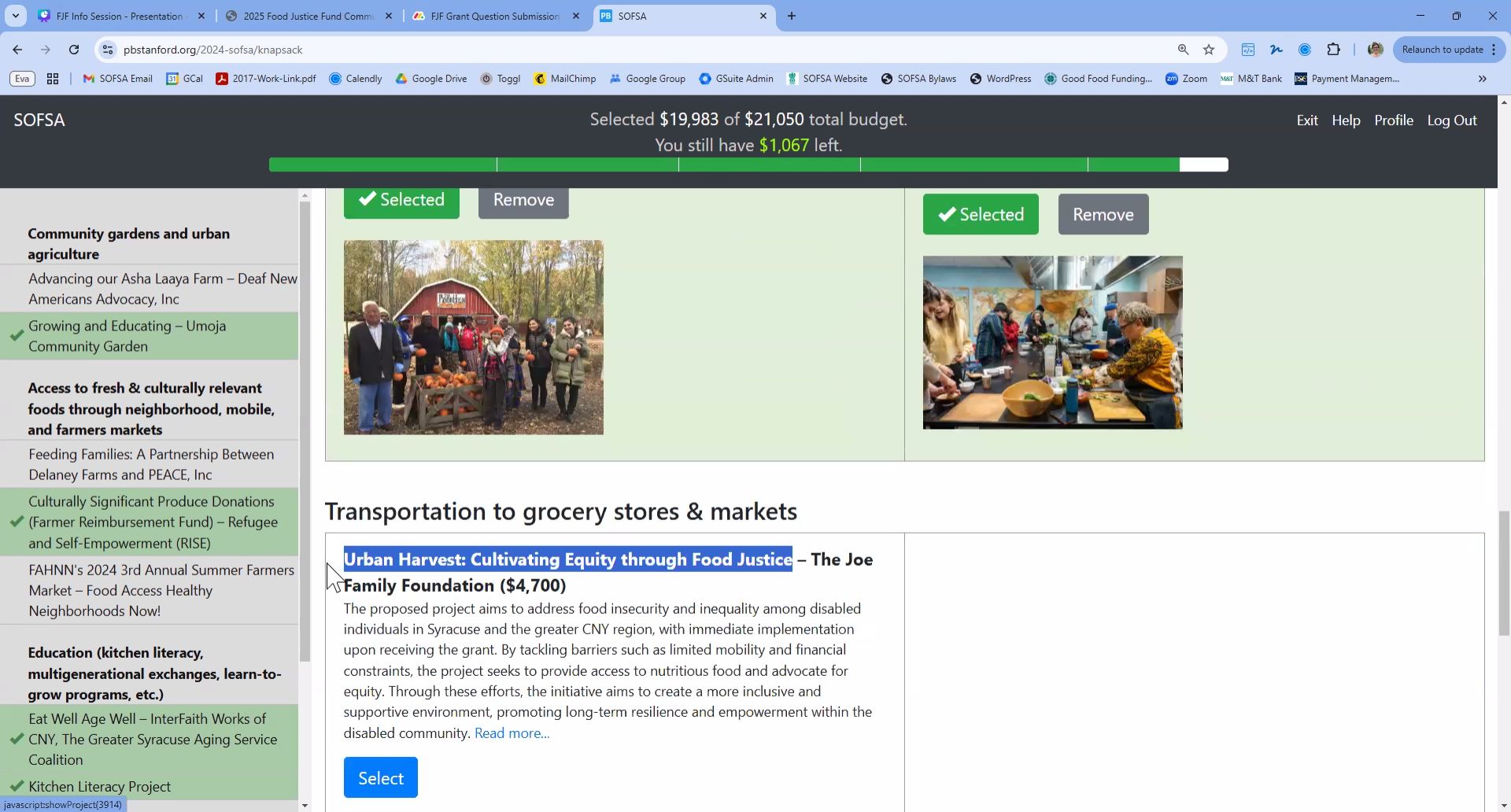
 and the three advisors with that key dates, obviously, today is our info session. We are committing to getting this recording.
and the three advisors with that key dates, obviously, today is our info session. We are committing to getting this recording.
+14













 and the three advisors with that key dates, obviously, today is our info session. We are committing to getting this recording.
and the three advisors with that key dates, obviously, today is our info session. We are committing to getting this recording. 00:0000:00